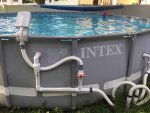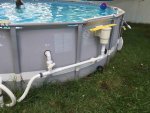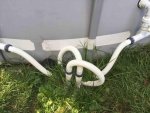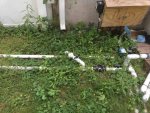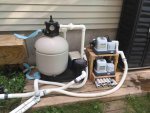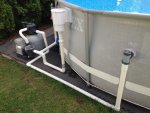I have an 18' x 9' Intex Ultra Frame going on it's 3rd summer. Last week one of the cheap ribbed inlet hoses they supply started cracking and leaking. I replaced it with some flexible PVC hosing I happened to have, and it seems to be working. It got me thinking about replacing all of the factory hoses with schedule 40 pipe and fittings. I work for a company that makes custom pvc fittings and sells molded fittings, so I can get my hands on just about anything I would need, but I am wondering about the rigidity of the piping. When the kids are splashing around, the sides of the pool flex back and forth like it's supposed to. If I have PVC piping, won't that damage the liner? I have these visions of a moving liner against the non-moving pipes, and having a hole torn in the liner. I've seen lots of pics doing this, and I would love to but I'm concerned about this.
Rigid PVC plumbing question
- Thread starter Phideaux
- Start date
You are using an out of date browser. It may not display this or other websites correctly.
You should upgrade or use an alternative browser.
You should upgrade or use an alternative browser.
I don't have an Intex, so I can't speak from experience, but my best guess is that the reason most people who hard plumb an Intex Pool leave the pipe on top of the ground is two fold:
1. To aid in the flex factor that you speak about.
2. Because these pools are seasonal for many (taking them down and putting them up each season), it just makes more sense.
I actually just got through installing and hard plumbing my 18' Steel Wall Above Ground - I can't imagine putting the pipes in the ground for an Intex. It adds to a whole new level of complexity to the equation. I am 100% glad I bit the bullet and did it, but it took me a good day - day and a half. Part of that was working out leaks from the installer on the pump. Seemed like I would fix one only to have another pop up. Sure, I could have called him back out, but then I am waiting around and he probably would just do the same crummy job he did to begin with. I will say, other than the hose assembly from the pump to the sand filter, everything else went smooth and having them install it was the best $$ I ever spent.
1. To aid in the flex factor that you speak about.
2. Because these pools are seasonal for many (taking them down and putting them up each season), it just makes more sense.
I actually just got through installing and hard plumbing my 18' Steel Wall Above Ground - I can't imagine putting the pipes in the ground for an Intex. It adds to a whole new level of complexity to the equation. I am 100% glad I bit the bullet and did it, but it took me a good day - day and a half. Part of that was working out leaks from the installer on the pump. Seemed like I would fix one only to have another pop up. Sure, I could have called him back out, but then I am waiting around and he probably would just do the same crummy job he did to begin with. I will say, other than the hose assembly from the pump to the sand filter, everything else went smooth and having them install it was the best $$ I ever spent.
I can't imagine putting the pipes in the ground for an Intex.
I wouldn't put them in the ground either. I would want to pack it all up in the Fall, plus I just don't have the gumption to do that. I was thinking that after connecting to the pup, the piping would be solid and the pipe itself would not flex and move with the sides of the pool.
ksguy
0
I think you have a couple of options. Option one is to use a short length of flex PVC at the skimmer and return jet and join that to rigid PVC a foot or two from the connection - that would give an area of pipe that has flex. Alternatively you could use Fernco couplings. They are not pressure rated beyond 4.3 PSI, but on the suction side it wouldn't matter, and on the return jet side the pressure is minimal. I think most of the pressure in the system is between the pump and the filter.
If it were me I'd do the flexible PVC. I'd run a length of flex PVC from the skimmer outlet down to level with the pump inlet, and then connect a rigid elbow and use rigid pvc from there to the pump, pump to filter, and out the return side of the filter. At the return jet I'd do like on the skimmer - flex PVC from the return down to level with filter outlet where it connects into the rigid PVC coming from the filter.
If it were me I'd do the flexible PVC. I'd run a length of flex PVC from the skimmer outlet down to level with the pump inlet, and then connect a rigid elbow and use rigid pvc from there to the pump, pump to filter, and out the return side of the filter. At the return jet I'd do like on the skimmer - flex PVC from the return down to level with filter outlet where it connects into the rigid PVC coming from the filter.
mikepier
Well-known member
GregN
0
As others have recommended above, I used a combination of flex pvc for last few feet of connections and the rest hard pvc. I liked the ability of the flex pvc to move w the pool sidewalls during active play in pool.
Everything above ground w ball valves and threaded unions for easy disassembly and winter storage. I don't believe that you loose much flow efficiency w the flex given the short distances.
Good luck,
Greg
Everything above ground w ball valves and threaded unions for easy disassembly and winter storage. I don't believe that you loose much flow efficiency w the flex given the short distances.
Good luck,
Greg
Thread Status
Hello , This thread has been inactive for over 60 days. New postings here are unlikely to be seen or responded to by other members. For better visibility, consider Starting A New Thread.


